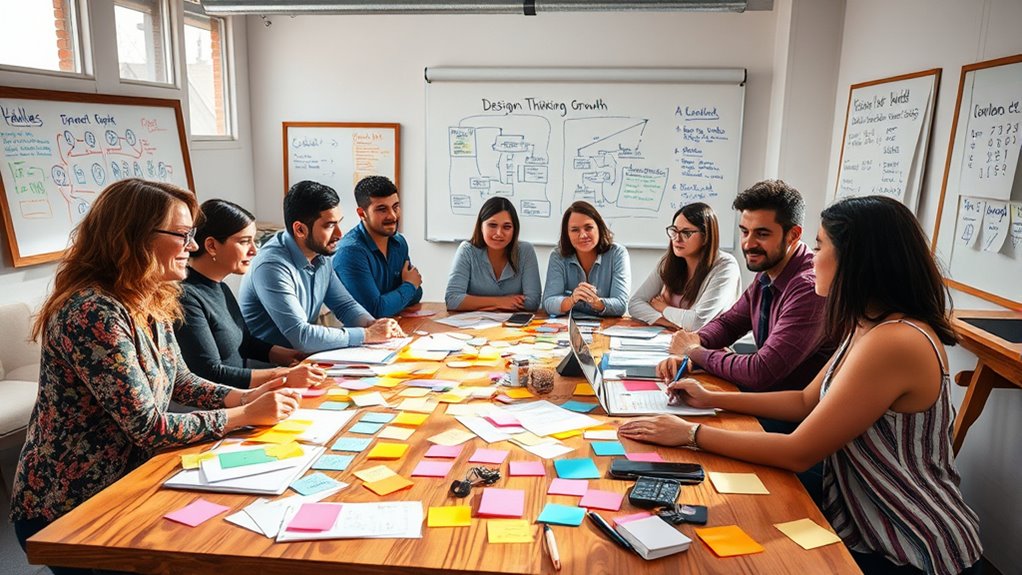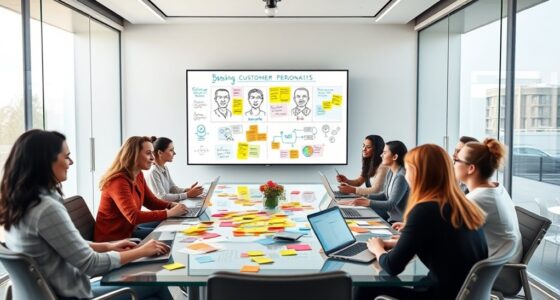To scale social impact using design thinking, immerse yourself in communities to understand their needs with empathy, actively listening and observing without assumptions. Test ideas through rapid prototyping, gathering feedback and refining solutions based on data. Build strong cross-sector partnerships that align shared goals and leverage diverse expertise. Foster a culture of innovation within your organization, empower volunteers and staff, and constantly measure your impact for sustainable growth. Continue exploring these lessons to unleash transformative change.
Key Takeaways
- Engage community members actively to ensure solutions are culturally sensitive, empathetic, and truly address their needs.
- Use iterative prototyping and data visualization to refine ideas rapidly and scale impactful solutions effectively.
- Build cross-sector partnerships with shared goals, open communication, and mutual trust to expand social reach.
- Foster a culture of innovation by encouraging experimentation, agility, and learning from failures.
- Empower staff and volunteers through targeted training, measurable impact metrics, and sustainable practices for long-term social change.
Embracing Empathy to Understand Community Needs

To truly understand a community’s needs, you must embrace empathy as a foundational step. Engaging in genuine community engagement helps you see the world through their eyes, revealing real challenges and aspirations. Cultural sensitivity plays a critical role; it ensures you’re respectful of diverse traditions, beliefs, and practices. By actively listening and observing, you gain insights that aren’t visible on the surface. Avoid assumptions and approach interactions with humility, recognizing that understanding develops over time. When you prioritize empathy, you build trust and create space for community voices to shape solutions. This authentic connection is essential in designing initiatives that truly resonate and have lasting impact. Remember, empathy isn’t just an act—it’s a mindset that guides your approach to social change. Additionally, understanding the best anime movies can inspire creative storytelling approaches that resonate emotionally with diverse audiences.
Iterative Prototyping for Scalable Solutions

You can develop scalable solutions by using rapid experimentation cycles to test ideas quickly. As you gather feedback, refine your prototypes through multiple iterations to improve effectiveness. This iterative process helps guarantee your solution is both adaptable and impactful at scale. Incorporating proper application timing ensures that your interventions are most effective when aligned with user routines.
Rapid Experimentation Cycles
How can teams quickly test and refine ideas to create scalable social impact? The answer lies in rapid experimentation cycles. By embracing iterative feedback, you can continuously improve your solutions through rapid prototyping. This approach allows you to gather real-time insights, identify flaws early, and adjust swiftly. Instead of waiting for perfect solutions, you release simple prototypes, observe how users interact with them, and learn from their responses. These short cycles help you validate assumptions, reduce risks, and optimize your approach efficiently. Rapid experimentation empowers you to stay flexible, adapt to changing needs, and accelerate progress toward impactful, scalable solutions. Consistently applying iterative feedback ensures your social innovations are both effective and sustainable in the long run. Cookies and user consent are important considerations when deploying digital solutions for social impact.
Refining Through Iteration
Building on rapid experimentation, refining your solutions through iterative prototyping allows for continuous improvement and greater scalability. You achieve this by engaging stakeholders early and often, ensuring their feedback shapes each version. Creative brainstorming sessions help you explore new ideas and identify potential flaws, making your prototypes more robust. As you test and refine, keep an open mind, embracing failures as learning opportunities. This cycle of testing, learning, and adjusting keeps your solution aligned with real needs and adaptable to changing circumstances. By involving stakeholders in each iteration, you build trust and gain valuable insights, accelerating the path to scalable, impactful solutions. Ultimately, iterative refinement transforms initial concepts into polished, effective models ready for broader implementation. Incorporating home decor and design principles can also inspire innovative approaches to social impact solutions.
Building Cross-Sector Partnerships for Greater Reach

Building cross-sector partnerships starts with aligning shared goals that motivate all stakeholders. By leveraging each partner’s unique expertise, you can develop more innovative and effective solutions. Sustaining collaborative momentum guarantees these efforts continue to expand your reach and create lasting social impact. Incorporating active listening and empathy into your collaboration process fosters deeper understanding and stronger connections among partners.
Aligning Shared Goals
Aligning shared goals is essential when forming cross-sector partnerships because it guarantees all stakeholders are working toward a common purpose. A shared vision creates clarity, ensuring everyone understands the broader impact you aim to achieve. When your partners coordinate their goals around a common purpose, it fosters trust and commitment, making collaboration more effective. To do this, engage openly in conversations to clarify expectations and priorities. Clearly define the shared vision early on, so all parties are on the same page. This alignment helps prevent misunderstandings and keeps efforts focused on the social impact you’re endeavoring for. Remember, when everyone works toward the same goal, your collective strength increases, enabling you to scale your impact more efficiently. Additionally, understanding and leveraging efficiency ratings can help optimize the performance of collaborative initiatives.
Leveraging Diverse Expertise
When partners align their goals, they open the opportunity to combine their unique skills and knowledge. This is the essence of leveraging diverse expertise through interdisciplinary collaboration. By bringing together individuals from different sectors, you tap into a wide range of perspectives and approaches, enriching the problem-solving process. Diverse skillsets enable your team to address complex social issues more effectively, as each partner contributes specialized insights. Building cross-sector partnerships allows you to access resources, networks, and innovative ideas that wouldn’t be possible alone. Embracing this diversity fosters creativity and resilience, helping you develop more holistic solutions. Additionally, understanding signs of spoilage in consumables can inform health-conscious decisions in community initiatives. Ultimately, leveraging diverse expertise expands your reach and impact, making your initiatives more adaptable and sustainable in tackling social challenges.
Sustaining Collaborative Momentum
Sustaining collaborative momentum is essential for maximizing the impact of cross-sector partnerships over time. To keep everyone engaged, use motivational storytelling to highlight successes and inspire continued commitment. This approach builds shared purpose and reinforces the partnership’s value. Equally important is effective resource allocation—ensuring each partner contributes what they can and receives support where needed. Clear communication about roles and expectations prevents drift and keeps the collaboration focused. Celebrate milestones to maintain enthusiasm and demonstrate progress. When you prioritize ongoing engagement through storytelling and strategic resource management, you foster trust and resilience. This sustained momentum ultimately enables your partnership to expand its reach and deepen its social impact, creating lasting change rooted in shared vision and collective effort. Additionally, understanding cookie categories helps ensure that your digital engagement strategies remain transparent and respectful of user preferences.
Cultivating a Culture of Innovation Within Non-Profits

Creating a culture of innovation within non-profits requires intentional effort and a mindset that encourages experimentation and learning. You must foster creative leadership that empowers team members to take risks and share ideas openly. This involves promoting organizational agility—adapting quickly to new challenges and opportunities without fear of failure. When leaders model a growth mindset, it becomes easier for staff to embrace change and pursue innovative solutions. Encourage collaboration across departments to spark fresh perspectives and break down silos. Recognize and celebrate experimentation, even when it doesn’t succeed initially. By intentionally nurturing a climate of trust and curiosity, you’ll create an environment where high-quality projectors thrive, helping your non-profit stay responsive, impactful, and sustainable in a competitive landscape.
Leveraging Data to Refine and Expand Programs

Leveraging data effectively enables you to make informed decisions that refine existing programs and identify opportunities for expansion. By analyzing key metrics and using data visualization tools, you can uncover patterns and insights that might otherwise go unnoticed. Clear visualizations help communicate complex information quickly, making it easier to assess program performance and areas for improvement. This process supports program scalability by highlighting successful elements worth replicating and scaling up. As you gather more data, you can test new strategies, optimize resource allocation, and refine your approach to maximize impact. Understanding IRA investing strategies can further inform resource planning and long-term sustainability. Ultimately, data-driven decision-making ensures your programs evolve based on real evidence, increasing their effectiveness and sustainability over time.
Navigating Challenges During Growth Phases

As your social impact program begins to grow, you’ll inevitably face new challenges that can hinder progress if not addressed promptly. One key challenge is resource allocation; as demand increases, you need to ensure funds, staff, and time are distributed effectively to sustain momentum. Misallocating resources can stall progress or dilute your efforts. Additionally, stakeholder engagement becomes more complex; maintaining strong relationships with donors, partners, and beneficiaries requires transparency and consistent communication. During growth phases, people’s expectations evolve, and if engagement efforts lag, you risk losing support. To navigate these challenges, stay flexible and prioritize clear communication. Regularly reassess resource needs and keep stakeholders informed, fostering trust and alignment. This proactive approach guarantees your program scales successfully without losing its core impact.
Empowering Staff and Volunteers Through Design Thinking

As your program grows, empowering your staff and volunteers becomes essential to maintaining momentum and sustaining impact. Using design thinking helps you motivate volunteers by involving them in problem-solving and decision-making, making their contributions more meaningful. To do this effectively, focus on designing training that emphasizes empathy, creativity, and iterative learning. Engage volunteers in hands-on activities that encourage them to experiment and share ideas openly. When volunteers feel valued and equipped with the right skills, they’re more motivated and committed. This approach also helps identify their unique strengths and challenges, fostering a culture of continuous improvement. Ultimately, empowering your team through design thinking creates a resilient, innovative environment where everyone actively contributes to social impact.
Measuring Impact to Drive Sustainable Change

How can you guarantee that your social initiatives create lasting change? The key is measuring impact through clear outcome metrics and understanding your social return. By setting specific, measurable goals, you can track progress beyond outputs, focusing on real change. Regularly evaluating outcome metrics helps you identify what’s working and what’s not, allowing you to adapt strategies for greater effectiveness. Social return on investment (SROI) offers a thorough view of your initiative’s value, capturing social, economic, and environmental benefits. This approach ensures you’re not just achieving short-term wins but fostering sustainable, long-term impact. Ultimately, diligent measurement keeps your team aligned, accountable, and committed to scaling solutions that genuinely improve lives.
Frequently Asked Questions
How Can Non-Profits Sustain Innovation Financially Over the Long Term?
To sustain innovation long-term, you need to focus on funding diversification and innovative revenue models. Relying on a single funding source can be risky, so explore grants, donations, social enterprise ventures, and partnerships. Developing multiple revenue streams helps you maintain financial stability and adapt to changing landscapes. By continuously diversifying your funding and refining your revenue models, you guarantee your organization stays innovative and impactful over time.
What Are Common Pitfalls When Implementing Design Thinking in Non-Profit Scaling?
When implementing design thinking in scaling efforts, don’t bite off more than you can chew. Common pitfalls include misaligned stakeholder expectations and poor resource allocation, which can derail progress. You might find it challenging to keep everyone on the same page or to dedicate enough resources to sustain innovation. To avoid these, guarantee clear communication and prioritize stakeholder engagement, so your efforts stay focused and effective.
How Do Non-Profits Balance Community Needs With Organizational Goals?
To balance community needs with organizational goals, you prioritize community engagement, ensuring voices are heard and needs are understood. You allocate resources strategically, focusing on initiatives that benefit both the community and your mission. Regular communication helps align goals and adapt to changing needs. By involving community members in decision-making and being transparent about resource use, you create a sustainable balance that fosters trust and impact.
How Can Non-Profits Measure Intangible Social Impacts Effectively?
You might think measuring social impact is impossible, but you can succeed by focusing on qualitative metrics and stakeholder feedback. These tools help you capture stories and insights that numbers alone can’t demonstrate. By actively listening to community voices, you ensure your efforts truly matter. It’s rewarding to see how heartfelt stories and feedback reveal the real change you’re creating, beyond what traditional metrics can measure.
What Strategies Help Non-Profits Overcome Resistance to Change Internally?
When facing resistance to change, you should prioritize change management strategies that foster stakeholder engagement. Clearly communicate the benefits of new initiatives, involve team members in decision-making, and address their concerns openly. By building trust and understanding, you make it easier to overcome internal resistance. Consistently engaging stakeholders throughout the process helps create buy-in and guarantees smoother shifts, making your organization more adaptable and resilient to change.
Conclusion
As you embrace design thinking, you’ll find that empathy and iteration naturally lead to impactful solutions. Sometimes, a simple partnership or a small pivot can unexpectedly scale your efforts far beyond what you imagined. Remember, fostering innovation and measuring what matters keeps your mission alive. In this journey, even a chance encounter or a new idea can open doors you hadn’t seen before—proof that the right mindset turns possibilities into reality.









